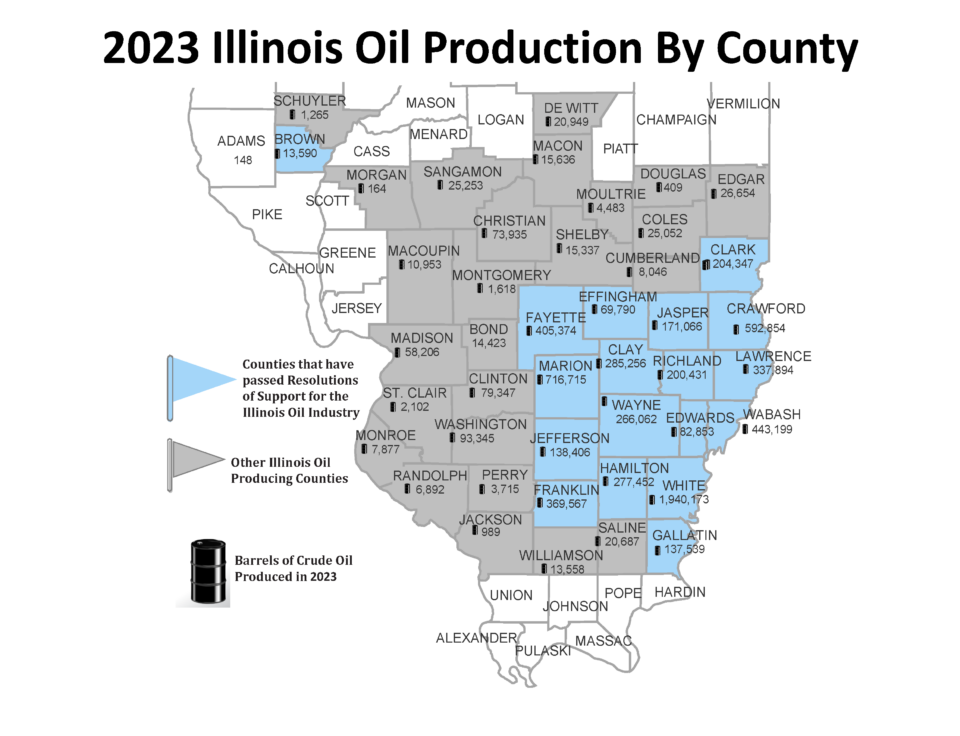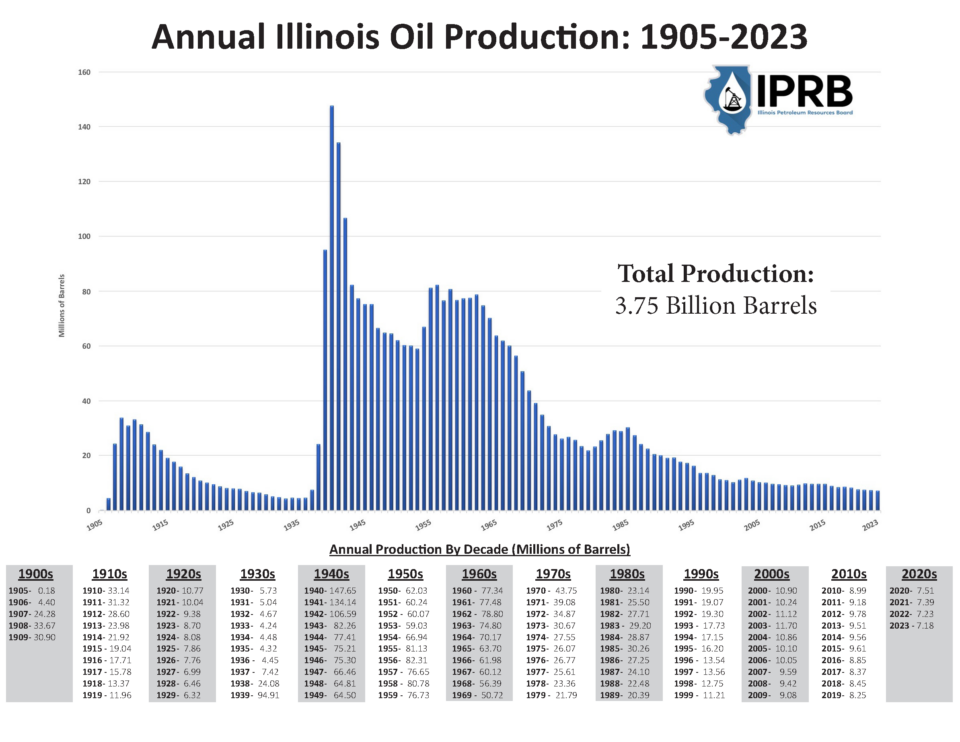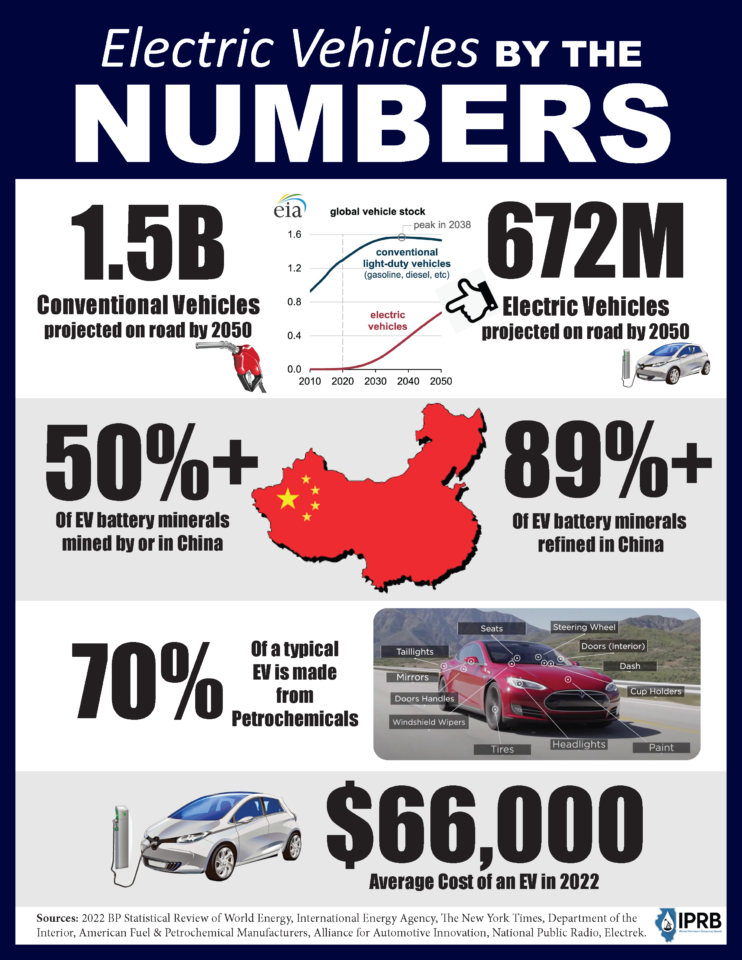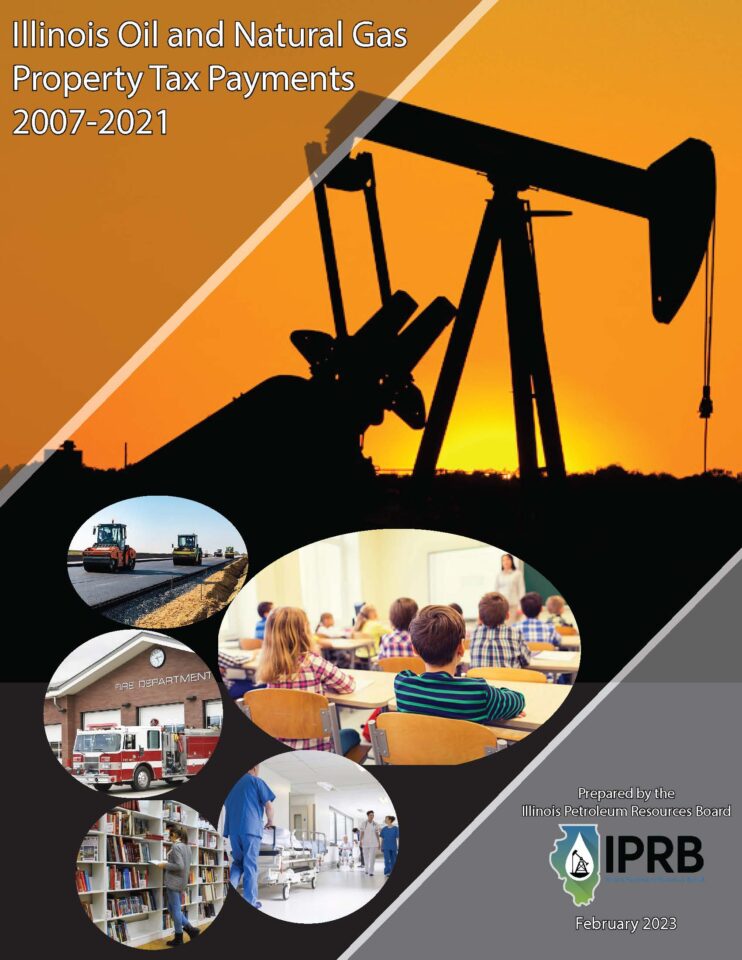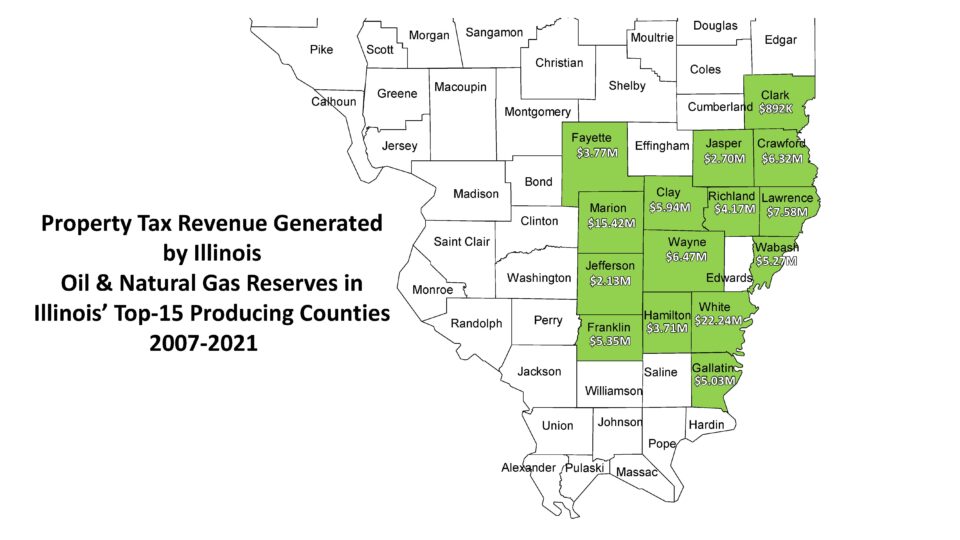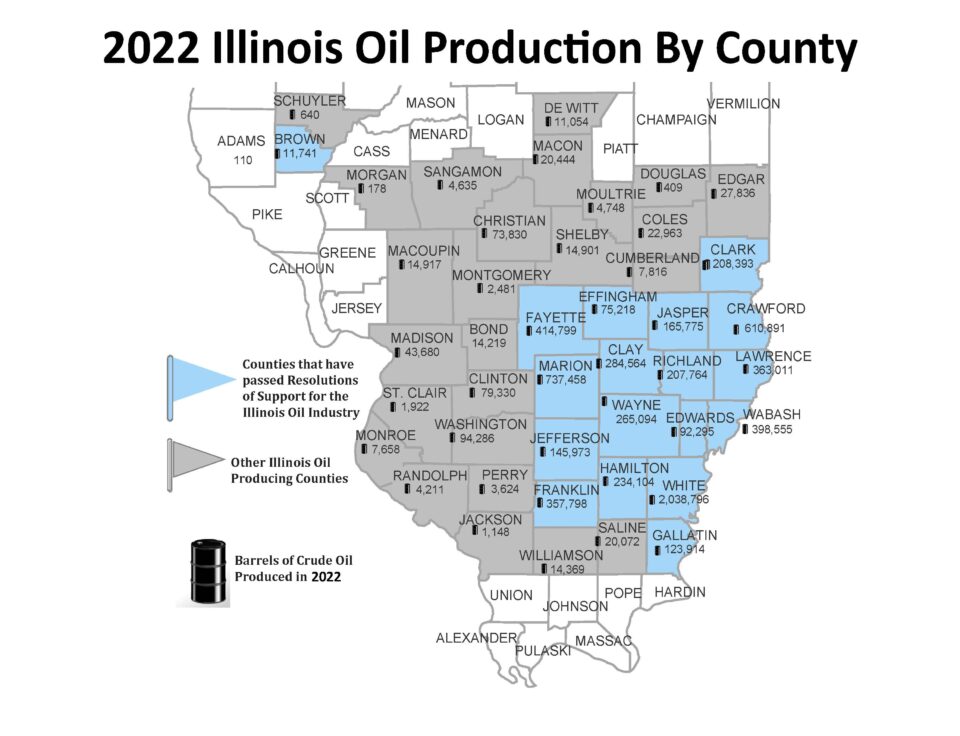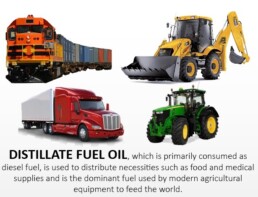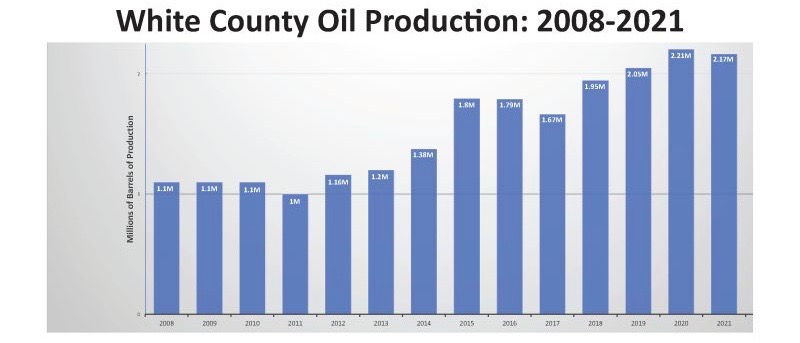Illinois Crude Oil Production Totaled 7.18M Barrels in 2023
Illinois crude oil production totaled 7,184,282 barrels in 2023, according to data compiled by the Illinois Petroleum Resources Board (IPRB) that is based on first-purchaser reports. Click here to download IPRB’s annual Illinois oil production report.
The state’s 2023 production 0.59 percent below 2022 production levels (7,227,172 barrels).
Several counties did see significant increases in production compared to 2022 levels, led by Wabash County’s 44,644-barrel increase in production to 443,199 barrels in 2023. That made Wabash County Illinois’ fourth-largest oil producing county despite being one of the smallest counties geographically in the state.
Hamilton County saw a similar year-over-year production increase in 2023, with production jumping 43,349 barrels to 277,452 barrels – making it Illinois’ No. 9 producing county.
Franklin County saw a third straight year of increased production, as its production jumped three percent compared to 2022 levels to a total of 369,567 barrels last year. Franklin County enjoyed a 15 percent production increase from 2021 levels in 2022 and has increased production nearly 42 percent from 2020 levels over the past three years, catapulting it to become the state’s sixth most prolific producing county.
Minor producing counties Sangamon (+20,618 barrels), Madison (+14,527), Dewitt (+9,865), Randolph (+2,6981), Coles (+2,090) and Brown (+1,849) all saw significantly increased production last year, while traditional top-15 producing counties Gallatin (+13,625), Jasper (+5,290), Wayne (+968) and Clay (+692) enjoyed upticks in production compared to 2022.
White County once again led the state in production by a wide margin (1,940,173 barrels), although its production decreased by 98,623 barrels compared to 2022.
The state’s top-15 producing counties – White, Marion, Crawford, Fayette, Lawrence, Wabash, Franklin, Clay, Wayne, Clark, Richland, Hamilton, Jasper, Jefferson and Gallatin – collectively produced 90 percent of the state’s oil in 2023. All 15 of those counties – as well as Edwards, Brown and Effingham counties – have passed Resolutions of Support for the Illinois oil production industry.
Illinois has totaled more than 3.75 billion barrels of oil production since commercial production began in 1905.
Demise of Gasoline-Powered Vehicles Has Been Greatly Exaggerated
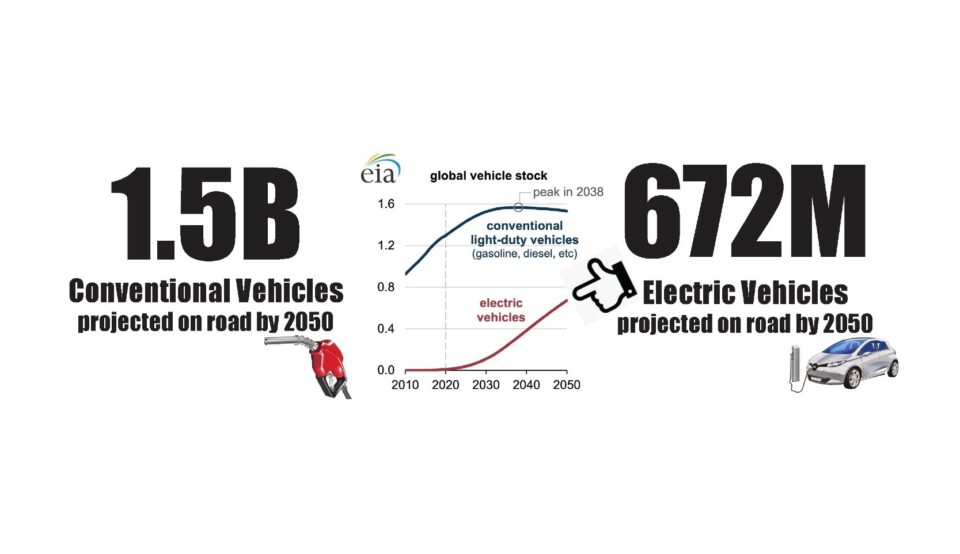
The chasm between electric vehicle hype and reality was never more profound than during last year’s Super Bowl.
You may recall seeing one electric vehicle commercial after another during the big game. The ads were slick. They were hip. And based on their frequency, one might guess the EV revolution just around the corner. Instead, headline after headline throughout 2023 confirmed an undeniable truth: The demise of internal combustion engine (ICE) vehicles has been greatly exaggerated.
Contrary to the prevailing narrative, new gasoline vehicle registrations continued to rise both in the United States and throughout the world last year. The world also used more gasoline than ever in 2023. And although the number of electric vehicles (EVs) in the United States has increased to about three million, that figure is dwarfed by the 265 million-plus conventional vehicles on American roads.
There are many reasons automakers are cutting back on plans to dramatically expand EV manufacturing and nearly 4,000 auto dealers penned a letter urging President Biden to “tap the brakes” on proposed emissions regulations that would mandate two-thirds of new vehicle sales be electric by 2032.
A December Consumer Reports analysis found EVs have nearly 80 percent more issues and are less reliable overall than their ICE counterparts. EVs are also generally more expensive, more costly to insure and tougher to repair than conventional vehicles.
No wonder a University of Chicago poll released last year found nearly half of Americans say they are unlikely to buy an EV any time soon. Just 19 percent of the respondents said it’s “very” or “extremely” likely they would buy an EV when they next go vehicle shopping. And another survey found 45 percent of Americans would be upset if gasoline-powered cars were phased out.
With more than a billion conventional passenger vehicles on the road worldwide and countless headwinds for widespread EV adoption – most notably lack of charging infrastructure and heavy reliance on China for battery materials and manufacturing – it’s time EV advocates stop pushing unpopular and impractical mandate proposals and accept reality: EVs and conventional vehicles can, and will, coexist for decades to come. And they can do so while both becoming more protective of the environment.
Contrary to popular belief, EVs are not “green” emissions-free climate panaceas – their emissions just happen to come from somewhere other than a tailpipe. The Wall Street Journal reported in 2021 that carbon dioxide emissions from a Tesla Model 3 are actually higher than a Toyota RAV4 for the first 20,000 miles the vehicles are driven. And as the New York Times recently reported, “Electric cars and renewable energy may not be as green as they appear. Production of raw materials like lithium, cobalt and nickel that are essential to these technologies are often ruinous to land, water, wildlife and people.”
Conventional cars obviously release carbon dioxide and other tailpipe emissions. But ICE vehicles have become far less polluting and more fuel efficient over the past 50-plus years.
U.S. Environmental Protection Agency data show that although the number of passenger vehicles on American roads has more than doubled and total miles driven has tripled since 1970, overall U.S. aggregate emissions of the six most common pollutants have declined 78 percent and CO2 emissions have declined nine percent during that time-span. The EPA also reports that new passenger vehicles are 98 to 99 percent cleaner for most tailpipe pollutants than they were in the 1960s.
To be clear, this emissions progress needs to continue trending in the right direction, and emission reduction innovation should be prioritized. But the notion that banning ICE vehicles and mandating EVs will eliminate all emissions is misleading.
These facts illustrate why the Alliance for Automotive Innovation – which represents companies responsible for more than 96 percent new vehicles sold in the United States – has commented that proposed tailpipe regulations that would effectively mandate EVs are “neither reasonable nor achievable in the time frame covered in this proposal.”
Average Americans count on their conventional passenger vehicles for reliable, affordable and essential transportation. So despite all the EV hype you’ll likely see again this Super Bowl Sunday, don’t be surprised if conventional vehicles still dominate American roads for years to come.
More Than 150 Attend 2nd Annual Illinois Basin Celebration

More than 150 Illinois Basin oil exploration and production industry professionals attended the second annual Illinois Basin Celebration at the 404 Seed Station in Carmi on Friday, Oct. 13.
The event was organized by the Illinois Petroleum Resources Board (IPRB) to recognize the efforts of the more than 4,000 Illinois Basin oil exploration and production industry professionals and featured a complimentary lunch and presentation by guest speaker Warren Martin of Kansas Strong.
Martin’s presentation focused on essential need for petroleum now and in the future, and the importance of industry advocacy by those who work in the oil and gas industry.

Kansas Strong executive director Warren Martin makes his presentation at the 2nd Annual Illinois Basin Celebration.
Complimentary “Illinois Basin Proud” hats, T-shirts, flags and bumper stickers were also handed out to attendees.
The event also included an IPRB Petro Pros presentation to a group Carmi-White County agriculture students by industry volunteers Mike Payne of Shawnee Oil Company, Ross Basnett of Campbell Energy, Travis Thompson of Travis Thompson Oil Corp. and IPRB executive director Seth Whitehead. Campbell Energy and Travis Thompson Oil Corp. also displayed various oilfield equipment for the Petro Pros volunteers to show the students.
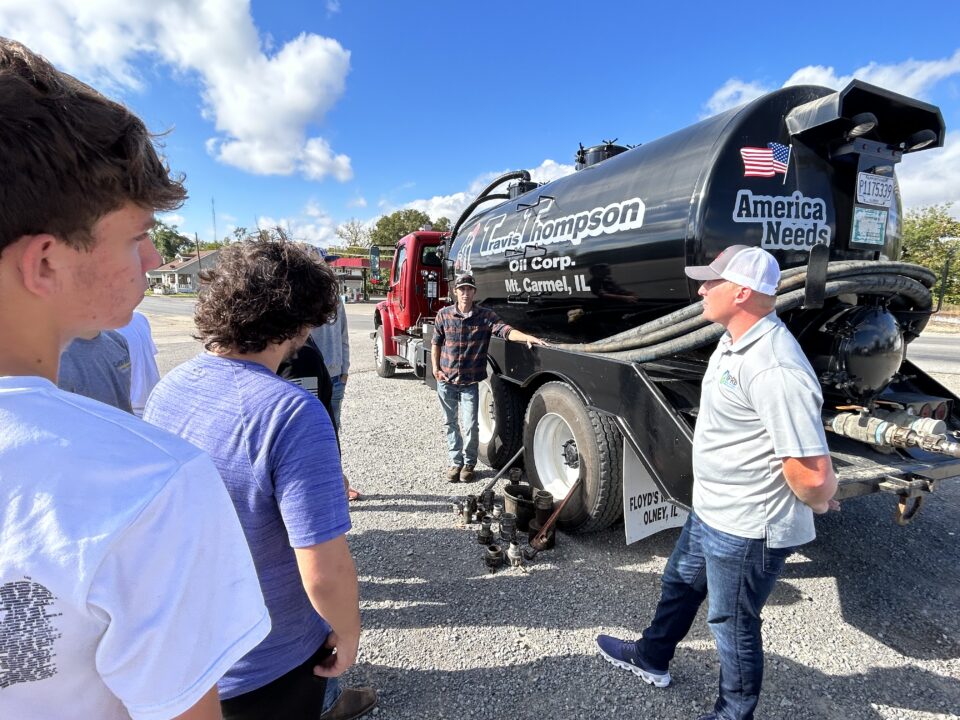
Travis Thompson and Eli Fears of Travis Thompson Oil Corp. conduct a tank truck demonstration.
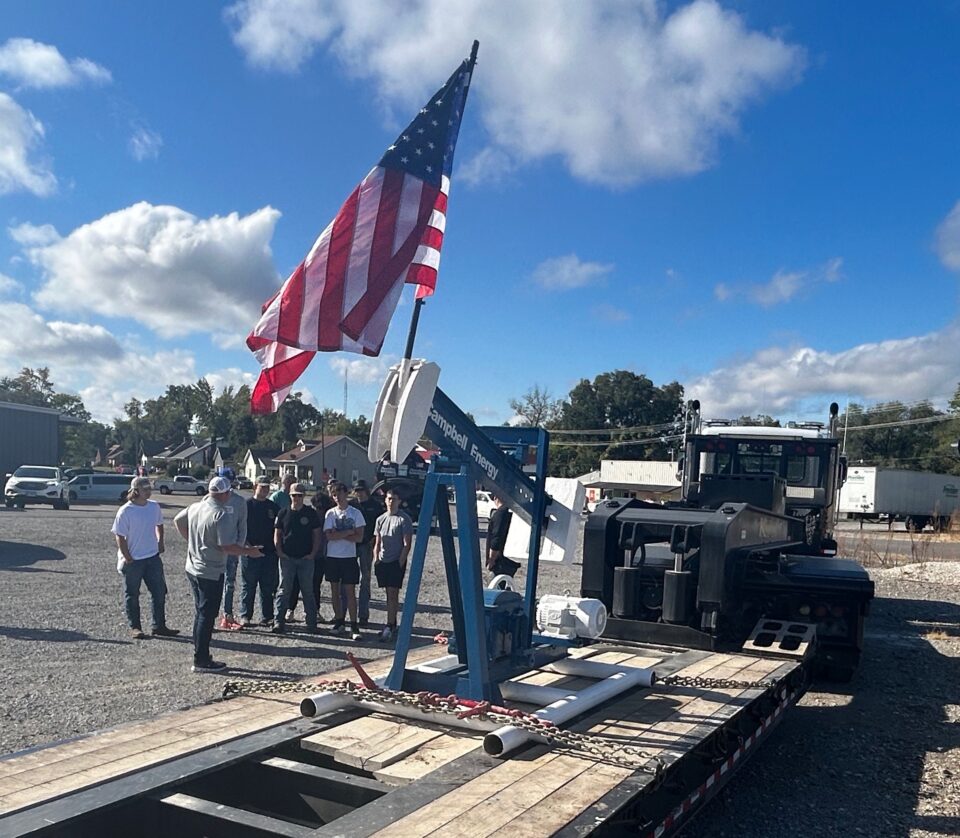
Travis Thompson of Travis Thompson Oil Corp. explains how a pumping unit works.
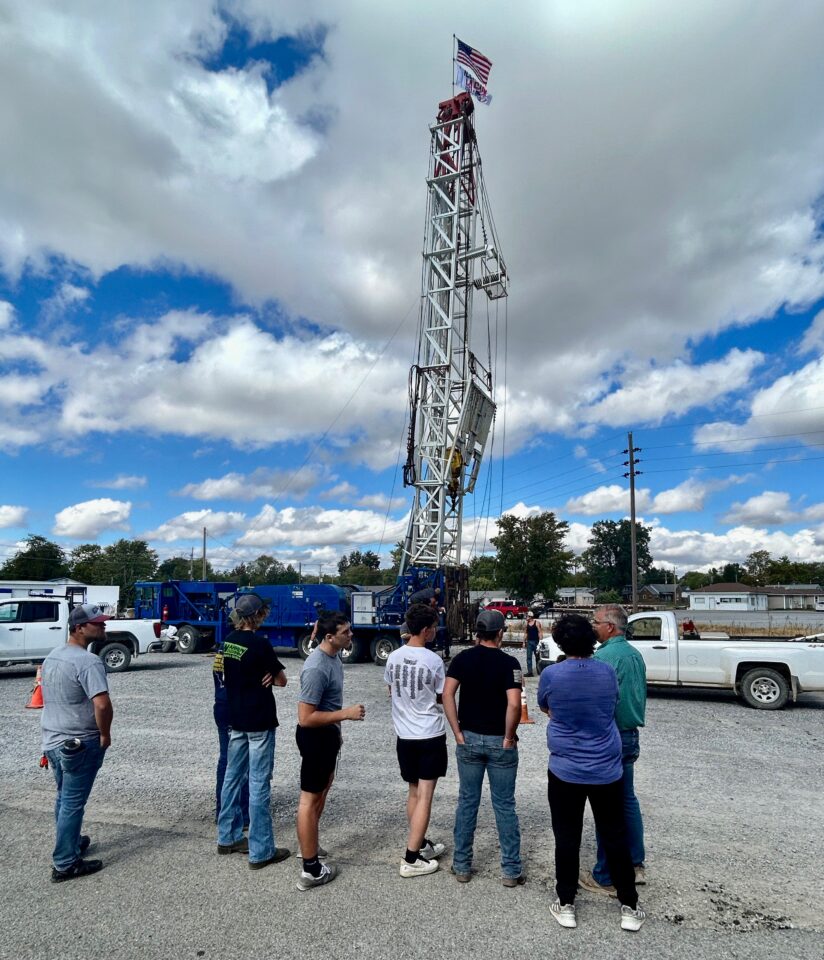
Carmi-White County agriculture students look on as Campbell Energy employees rig up a spudder.
The Petro Pros presenters also shared information with the Carmi-White County High School attendees about career opportunities in the Illinois Basin. There is currently high demand for almost all of the 75-plus oil exploration and production industry careers, with particularly high demand for truck drivers, electricians, plumbers, welders, roustabouts and various rig and well servicing crew members.
Most of the 150-plus attendees were able to stick around after lunch to pose for the above group photo.
Between 10-12 million barrels of oil is produced annually in the Illinois Basin, which includes southern Illinois, southwestern Indiana and western Kentucky.
Illinois oil production alone makes a $3 billion annual economic impact, generating $770 million in yearly personal and business income and $700 million in state and federal tax revenue. More than 30,000 Illinoisans receive royalty income from Illinois oil production, and active Illinois oil leases have generated an average of $7.24 million in local property tax revenue per year since 2007. More than half of that revenue has gone to fund schools near production.
The third annual Illinois Basin Celebration will be held next year in Carmi at a yet-to-be-determined date.


Why Americans Aren’t Likely to Embrace Electric Vehicle Mandates
You’d never guess it based on the nonstop barrage of slick TV ads and media hype, but Americans aren’t big fans of electric vehicles. In fact, a new Gallup poll shows that just four percent currently own an EV and four in 10 have no interest in buying one.
There are many legitimate reasons why this is the case. But U.S. consumers may have far less choice in the matter in the not-so-distant future.
Proposed U.S. Environmental Protection Agency rules would effectively mandate by 2032 that two out of every three new passenger vehicles sold in the United States are electric. And a handful of states will ban sales of new conventional vehicles starting in 2035.
The writing is on the wall: Choose to buy an EV now or be forced to do so later. To be clear, EVs have their place and everyone should be free to purchase one if they want. But there are plenty of red flags flapping in the strong winds blowing in an EV-only direction.
First and foremost, most Americans simply can’t afford an EV. The average cost of an all-electric passenger vehicle was $66,000 in 2022. Even Democrats are acknowledging that price tag is too much for most of their constituents. Rep. Debbie Dingell recently said, “Everybody cares about global warming, but I’m hearing from too many people in this country – I mean, strong Democrats – that they can’t afford an electric vehicle.”
And because EVs are dependent on foreign sources for massive quantities of battery minerals, their costs aren’t likely to decrease any time soon – especially if demand suddenly spikes due to mandates. It is because EV components are largely sourced from countries that have poor relationships with the United States and questionable labor practices that many EV models aren’t eligible for the generous $7,500 tax credit included in the Inflation Reduction Act.
Nearly 90 percent of EV battery minerals are refined by China, and half of EV battery minerals are either mined by or in China. More than 70 percent of the world’s cobalt is extracted in The Democratic Republic of the Congo – much of it by Chinese companies that use child labor. EVs require 2 ½ times the copper of conventional vehicles, which is good news for politically volatile Peru and Chile, which mine 40 percent of world’s most prominent “electrification metal.”
In other words, going “green” does not make us energy independent. It instead makes these countries the OPEC of alternative energy. Consumers are also rightly concerned about a lack of charging stations, further burdens on an already overextended electrical grid, poor battery performance in cold weather and limited battery lifespans in general.
But the environmental benefits of EVs far outweigh these issues, right?
Though EVs are responsible for less carbon dioxide emissions over their lifespans than their conventional counterparts, they are by no means “emission free” or a “green” climate change panacea.
It can actually take several years for an electric vehicles’ carbon footprint to drop below that of a conventional vehicle. The Wall Street Journal reported last year that emissions attributable to the Tesla Model 3 are higher than the gasoline-burning Toyota RAV4 for the first 20,000 miles that the vehicles are driven. Assuming both vehicles are driven 200,000 miles, the lifecycle carbon footprint of the RAV4 winds up being 78 tons of CO2 emissions, compared to 36 tons for the Tesla Model 3.
Even the New York Times reports, “Electric cars and renewable energy may not be as green as they appear. Production of raw materials like lithium, cobalt and nickel that are essential to these technologies are often ruinous to land, water, wildlife and people.”
These are just a few of the reasons four out of 10 Americans have no plans to buy an EV now or in the future. The hesitation is simple: affordable, reliable transportation is a necessity for most Americans. Fortunately, conventional cars are becoming increasingly efficient while remaining far more affordable than EVs.
We will need all-of-the-above options for our transportation and energy needs for many years to come. EV mandates are tone-deaf to this reality.
Updated Report: Illinois Oil Reserves Generated $108.6M in Local Property Tax Revenue From 2007-2021
Many Illinoisans may not be aware that the state’s active oil production leases are assessed and taxed as real estate, similar to property taxes paid on a residential home. All of the revenue collected from this tax – known as an ad valorem tax – stays at the local level and goes directly to support the areas where oil is produced, including counties, villages, townships, cities, and – most importantly – local schools.
An IPRB review of the latest Illinois Department of Revenue (IDOR) data shows that Illinois oil reserves generated $108.6 million in ad valorem tax revenue from 2007 to 2021, an average of more than $7.24 million per year. IPRB details this revenue in an updated annual report that can be downloaded here and by clicking the image below.
IDOR data also show that nearly 60 percent of this $108.6 million in revenue went to fund K-12 public schools near production. For this year’s report, IPRB downloaded the exact percentage of ad valorem revenue that went toward K-12 public schools near production for each year of the report (2007-2021) in each producing county, finding approximately $64.8 million of the total $108.6M in ad valorem tax revenue collected from 2007-2021 went to fund K-12 public schools in producing counties. This is upwardly revised from IPRB’s previous reports (2019, 2020, 2021 and 2022), which had conservatively estimated 50 percent of the total oil reserve ad valorem revenue collected went to K-12 public schools near production.
Ad valorem tax revenue from Illinois oil production has a particularly significant impact in major producing counties. IDOR data show that ad valorem tax revenue in Illinois’ top-15 oil producing counties totaled $97.05 million from 2007-2021, an average of more than $6.47 million per year. See the graphic below for revenue totals in each of the state’s top-15 oil producing counties.
IPRB estimates that approximately $57.88 million of that revenue went to K-12 public schools in those top-15 producing counties.
It is important to note that many of these counties have relatively small populations and are relatively poor compared to many other state counties and the state as a whole. In fact, all but one of Illinois’ top oil producing counties (Crawford) have poverty rates that are higher than the national average – adding even more significance to the ad valorem tax revenue generated by oil and natural gas reserves in these counties. Just two percent of Illinois’ overall population resides in these top-15 producing counties, which are responsible for 90 percent of Illinois oil production.
County-level reports for each of Illinois’ top-15 producing counties can be downloaded at the links below. An example of the county-level reports can also be viewed below.
- White County
- Marion County
- Crawford County
- Lawrence County
- Fayette County
- Wabash County
- Wayne County
- Franklin County
- Clay County
- Richland County
- Hamilton County
- Clark County
- Jasper County
- Gallatin County
- Jefferson County
It is important to understand that these taxes are based on estimates of oil and gas reserves remaining in the ground, not oil and natural gas produced. The annual ad valorem tax bill that operators and royalty owners receive is also based on data that is over two years old. For example, ad valorem taxes paid in 2017 were based on a 2016 assessment of active leases that is calculated using 2015 production totals. There are also reductions for leases based upon lease age, secondary recovery methods used and production.
As complicated as the ad valorem tax calculation system may be, it is clear that these taxes are generating significant revenues in the communities where they operate, specifically for local schools.
Illinois Oil Production Totaled 7.22M Barrels in 2022
Illinois crude oil production totaled 7,227,842 barrels in 2022, according to data compiled by the Illinois Petroleum Resources Board (IPRB) that is based on first-purchaser reports. Click here to download IPRB’s annual Illinois oil production report.
The state’s 2022 production was 2.3 percent below 2021 production levels (7,397,119 barrels), as continued labor shortages and weather-related challenges trumped high oil prices and increased drilling activity, holding production down below 2021 levels.
Several counties did see significant increases in production compared to 2021 levels, however, led by Hamilton County’s 51,077-barrel increase in production to 234,104 barrels of production in 2022.
Franklin County saw a second straight year of sharply increased production, as its production jumped 15 percent compared to 2021 levels to a total of 357,798 barrels last year. Franklin County enjoyed a 19 percent production increase from 2020 levels in 2021 and has increased production 38 percent from 2020 levels over the past two years.
Wabash County increased production 12 percent in 2022 compared to 2021 levels with a total of 398,555 barrels. Christian, Richland, Dewitt, Sangamon, Clay, Crawford and Clinton counties all saw their production increase by at least 1,000 barrels in 2022 compared to 2021 levels.
White County once again led the state in production by a wide margin, topping two million barrels of production for the fourth straight year (2,038,796 barrels). However, that total was more than 127,303 barrels below 2021 production levels.
The state’s top-15 producing counties – White, Marion, Crawford, Fayette, Lawrence, Wabash, Franklin, Clay, Wayne, Clark, Richland, Hamilton, Jasper, Jefferson and Gallatin – collectively produced 90.2 percent of the state’s oil in 2022. All 15 of those counties – as well as Edwards, Brown and Effingham counties – have passed Resolutions of Support for the Illinois oil production industry.
Benefits of Fossil Fuels to Humanity Have Far Outweighed Negatives
The Natural Resources Defense Council claims fossil fuels have “exacted an enormous toll on humanity.” It is a belief shared and amplified by millions of “Keep It In the Ground” activists. But there are actually billions of examples why that opinion couldn’t be further from the truth. Eight billion, to be specific.
That latter figure happens to be the earth’s current population – eight times the amount of people that resided on the planet 200 years ago.
Prior to the wide-scale use of oil, natural gas and coal to make the high standard of living we enjoy today possible, eight out of 10 people lived in extreme poverty and most folks didn’t make it past their 30th birthday. As the Brookings Institute’s Samantha Gross recently wrote, “The pre-fossil era was not the utopia we envision.” Instead, it was rather miserable for a vast majority of the world’s occupants, most of which died far too young.
Fast forward a couple centuries, and the average person now lives more than 70 years and less than one in 10 people live in extreme poverty – the lowest level in human history. There has never been a better time to be alive. And it’s no coincidence fossil fuel use grew from almost nothing to 80-plus percent of the world’s energy supply over the past 200 years.
Contrary to the Natural Resources Defense Council’s claim that fossil fuels have “exacted an enormous toll on humanity,” the fossil fuel age has actually allowed humanity to flourish in unprecedented fashion. The examples why are almost too numerous to count.
Fossil fuels provide heat during the cold winter months, air conditioning during sweltering summer months and reliable electricity year-round. They have allowed access to healthcare via improved mobility, as well as medicines and petroleum-based healthcare products. They allow improved health in general by providing plentiful food, drinking water treatment and sewage management. These modern conveniences have improved the quality of life in the United States and other fortunate developed countries, leading directly to increased economic opportunity and longer lives, in general.
Even James Hansen, widely known as the father of global warming awareness, has said, “Let’s be clear: the frequent comparison of the fossil fuel and tobacco industries is nonsense. Fossil fuels are a valuable energy source that has done yeoman service for humankind.”
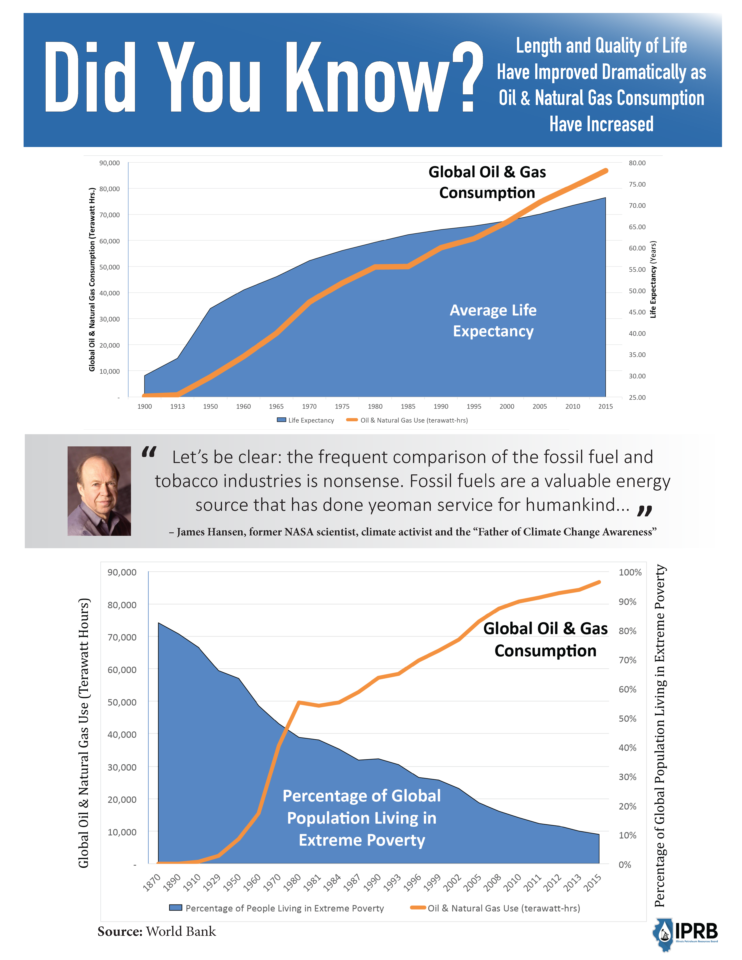
To be clear, fossil fuels, like all sources of energy, have environmental impacts. But it is dangerously misleading to focus exclusively on those impacts and completely ignore their massive benefits. And using this deeply flawed framing as the basis of campaigns to rapidly eliminate the source of 83 percent of the world’s energy and virtually all our modern products is even more dangerous considering the favored “alternatives” are completely inadequate to replace fossil fuels.
It can’t be emphasized enough that renewable energy – specifically wind and solar – can only generate electricity, and do so only when the sun is shining and the wind is blowing.
Wind and solar are not only unreliable for power generation, they provide no replacement for the thousands of uses for petroleum that are essential and largely taken for granted. More than 6,000 everyday products, including dozens of electronics such as smart phones and computers, are largely petroleum-based. Petrochemicals are even needed to manufacture wind turbines, solar panels and more than 70 percent of the typical electric car. As Vanclav Smil, Distinguished Professor Emeritus at the University of Manitoba, recently wrote in TIME magazine, each of the four pillars of modern civilization – ammonia fertilizer produced from natural gas, plastic, steel and cement – could not exist without fossil fuels.
Simply stated, if oil, natural gas and coal were rapidly eliminated as “Keep It In the Ground” groups such as the Natural Resources Defense Council advocate for, the voids created would be far worse than the issues fossil fuels create. That said, focus should center on pragmatically reducing emissions via technologies such as carbon capture and diversifying our energy supply will all forms of energy rather than irrationally eliminating fossil fuels before viable alternatives are available. Stubbornly insisting on the latter would actually take an “enormous toll” on the flourishment of humanity fossil fuels have made possible.
Diesel: The Underappreciated Lifeblood of Our Economy

With talk of possible diesel shortages making news this fall, it can’t be emphasized enough that the fuel is one of the most essential products in the world today. That might sound like hyperbole, but you don’t have to take the oil industry’s word for it.
According to the Biden administration’s Energy Information Administration, diesel engines power “most of the farm and construction equipment in the United States” and “help transport nearly all products people consume.” In other words – we can’t live without it. The undeniable necessity of the fuel is just one example of why the push to rapidly curtail U.S. petroleum production is so misguided. At worst, hundreds of millions would starve without diesel. At minimum, we would not be able to enjoy the vast array of modern products and conveniences we take for granted.
There are many reasons the United States’ transportation, healthcare, mining, construction and agricultural sectors use more than 46 billion gallons of diesel a year combined: it’s exceptionally energy-dense and reliable, and diesel engines are built to do the heavy-duty work that keeps America going.
Anyone who’s spent any time lately on our interstate highways or has had packages delivered to their doorstep can surely understand the importance of the fuel for use in over-the-road trucks alone. The U.S. Census Bureau’s Commodity Flow Survey shows that more than 71 percent of all goods shipped in the United States are transported by predominantly diesel-powered trucks, a figure that is only increasing.
What about the other 29 percent of goods shipped? Diesel also powers the freight trains, boats and barges that move products around the globe, accounting for the lions’ share of that remaining percentage.
Diesel-powered combines, tractors and other agricultural implements also make it possible to produce enough food to feed the world’s exploding population, while diesel-powered heavy equipment make the mining and construction that serve as the backbone of society possible. Hospitals also rely on backup diesel generators to provide continuous electricity even in the event of outages, literally saving lives.
But what about electrification? Won’t that make diesel fuel obsolete? Although electric passenger vehicles are becoming more common, our fleet of diesel-powered vehicles and equipment won’t be electrified any time soon. We need diesel. Lots of diesel. And we’re already seeing the consequences of allowing supply to wane.
U.S. diesel inventories have sunk to their lowest levels for this time of year on record. Although rumors that we are running out of diesel have been exaggerated, the supply-demand imbalance has driven prices well over $5 per gallon and prices are likely to soar even higher this winter. These elevated transportation costs for virtually all the products we consume will also likely continue to drive up the retail costs of these goods.
One of the primary reasons diesel prices have spiked is because U.S. refining capacity is down more than one million barrels per day from pre-Covid levels. Some refineries went out of business during the pandemic, while others succumbed to political and social pressure to focus on producing more “green” fuel alternatives. Most of the country’s 135 refineries are producing as much diesel as physically possible at the moment, but the fact remains that demand – driven by all of the diesel end-uses listed above – is outpacing their ability to supply the market. The loss of Russian barrels in response to Vladimir Putin’s invasion of Ukraine has only exacerbated this problem.
That’s why it’s imperative moving forward that we see a sincere bipartisan commitment to not only increase domestic oil production but up our refining capacity as well. That will require a shift in the hostile policies and contradictory rhetoric that has deliberately and successfully been aimed at discouraging investment. After all, the United States needs diesel fuel, along with a number of other essential petroleum products. Those who remain skeptical of those facts will likely learn the cold, hard facts this winter.
Illinois Oil Producers Doing Good Work In Their Communities
If you are a “downstate” Illinoisan, you have probably seen a pump jack or two nodding up and down somewhere near where you live and are aware there is significant oil production in the state. But a lot of Southern Illinoisans may not know that almost all the folks that drill and pump those oil wells that dot the countryside live in the same communities where they produce. The complete opposite of “Big Oil,” most Illinois oil producers are your neighbors and fellow small business owners. And a vast majority of those local oil producers are also doing good things in their respective Southern Illinois communities. Here are just a few examples.
Carmi-based Campbell Energy – the largest oil producer in the Land of Lincoln – recently received the Carmi Chamber of Commerce “Business of the Year” award in recognition of its service to the White County community.

Jake Campbell and John Campbell of Campbell Energy receive the Carmi Chamber of Commerce "Business of the Year" award.
As former Carmi Chamber president Amber Knight said prior to presenting Campbell Energy with the honor, “This company generously gives to many, many causes in White County. Their name can be seen on the backs of our kid’s uniforms, on banners for events and festivals and helping to keep some of our youth programs alive by donating money and equipment with no recognition at all. The impact that their existence has on our county can be seen in our economy, in our workforce and in our youth.”
Most notably, Campbell Energy recently provided funds and manpower to renovate an abandoned Carmi building into a community youth center.


404 Seed Station Youth Center Computer Lab
Just up the road in Fairfield, Podolsky Oil Company has been giving back to the Wayne County community for years through the Bernard and Naomi L. Podolsky Charitable Trust. The trust has made it possible for more than 900 Wayne County high school seniors to visit Washington D.C. over the past decade, covering roughly 60 percent of the annual trip’s expenses. This has allowed many kids who would otherwise not be able to afford such a trip to visit historical sites such as the Washington Monument, the Lincoln Memorial, the United States Holocaust Memorial Museum and Arlington National Cemetery, just to name a few.
Late Podolsky Oil founder Bernard Podolsky and son and current company president Michael have also been recognized for their various conservation endeavors, most notably earning former Gov. Jim Edgar’s “Illinois Outstanding Tree Farmer of the Year” award in 1991.
Just a little more up the road, Marion County-based Deep Rock Energy has contributed generously to the Kinmundy community in numerous ways, most visibly by largely funding and providing labor and expertise to construct a first-class youth softball facility and playground in the community.

Built on an eight-acre plot near South Central Elementary School, Webster Family Park features two softball fields and a playground. Prior to its construction, there was no softball field in Kinmundy and the community’s school and traveling teams were relegated to taking grounders in the Kinmundy United Methodist Church parking lot. Now, Kinmundy hosts several traveling team softball tournaments a year and its first-class facility has helped the South Central high school program emerge as a regional champion.
“I can’t say enough about what the Webster family has done and we wouldn’t have close to what we have without them,” Kinmundy Area Sports and Youth Opportunities Corporation board member Shawn Garrett said.
Collectively, all but one of Illinois’ 1,500-plus oil producers voluntarily contributes to the Illinois Petroleum Resources Board’s (IPRB) abandoned tank battery reclamation program. These voluntary industry funds have allowed IPRB to clean up more than 500 abandoned tank battery sites throughout state at no cost to landowners or taxpayers, improving the landscape while safeguarding the environment.
To be clear, an overwhelming majority of Illinois oil producers are responsible and properly remove oilfield infrastructure once their leases are no longer commercially productive. But there are some instances in which sites are abandoned for various reasons, most often because the responsible party has passed away. In response, the industry has collectively and proactively stepped up by contributing to this IPRB program that addresses these sites.
Illinois oil producers also contribute to their local communities via annual property taxes on oil reserves known as the ad valorem tax. Those taxes have generated an average of $7.4 million in local tax revenue per year since 2007. This revenue stays in producing counties, going to fund local municipalities and public services. Most notably, more than half of that revenue goes to fund public schools that are located near production sites.
So next time you see a pump jack or tank battery as you’re driving around Little Egypt, keep in mind that it is not only likely those oil production facilities are owned and operated by fellow Southern Illinoisans, but that those local oil operators are contributing to your local community in ways most are not aware of. Because they live, work and play on the same land as they produce on, a vast majority of Illinois oil producers proudly give back to their communities in a myriad of ways.
Campbell Energy Recognized For Community Service
Note: This blog post was updated on Oct. 7, 2022
The Illinois oil patch is unique in that almost all its producers not only live and work in the communities where they operate but are very active in those local communities as well. A shining example is Campbell Energy in Carmi, which was recognized for its community service and business success this week by receiving the 2022 Carmi Chamber of Commerce Business of the Year Award.

Campbell Energy Co-Founders Jake and John Campbell
“We are very fortunate to be a part of this community,” Campbell Energy co-founder and CEO Jake Campbell said after being presented the award. “We employ 115, 120 people from the area and we can’t do what we do without those 115, 120 people. We are very fortunate to have them, to retain them, to keep them and to keep finding new people to come in and help us.
"Receiving this honor at the Chamber dinner is a reflection of all 115 of us. We have been so blessed with the ability to work with such great people. It takes all 115 of us to make it work. What we have been blessed enough to do for the community also comes from all the hard work that all 115 of us do every day. So this award presented to us, from my perspective, is an award that is presented to all 115 and a testament of the work ethic and great job each and everyone does day in and day out. I am very appreciative, thankful, and blessed to work with such great people."
Campbell Energy’s business success is well known. The company has grown from producing less than 10 barrels per day in 2007 to being Illinois’ largest oil producing company at more than 4,000 barrels of production per day in 2022. Not only does Campbell Energy directly employ more than 115, it supports hundreds more jobs when the oil and gas industry’s jobs multiplier is taken into account (Every direct oil and gas job indirectly supports 5.43 other jobs, according to the Economic Policy Institute).
But less understood and just as impressive as the company’s business success is its contributions to the White County community – all of which were huge considerations to it receiving this honor.
“This company generously gives to many, many causes in White County,” former Carmi Chamber of Commerce president Amber Knight said prior to presenting Jake Campbell with the honor. “Their name can be seen on the backs of our kid’s uniforms, on banners for events and festivals, and helping to keep some of our youth programs alive by donating money and equipment with no recognition at all. The impact that their existence has on our County can be seen in our economy, in our workforce and in our youth.”
Knight highlighted Campbell Energy’s contributions to We Love White County Inc. (WLWC), a non-profit organization focused on bettering White County, and in particular Jake and wife Keyna’s passion for the WLWC’s Arrows youth empowerment program.
“We Love White County and the Arrows program would not be where it is today without this company and the people behind it,” Knight said. “It is the mission and vision of We Love White County to make our community a thriving place to live by investing in relationships. No one embodies this more than Jake and Keyna Campbell of Campbell Energy. They are invested not just financially in Arrows, but they are committed to loving and helping the people of the program and the people of White County. They are friends and helpers to the people of our community, and they carry this mindset into their business.”
The Campbells were instrumental in providing funds and manpower to renovate the old Brown’s Feed Store on Fifth Street in Carmi into a community youth center.


404 Seed Station Computer Lab

404 Seed Station Game Room


404 Seed Station Entrance/Lobby
“They not only spearheaded a complete renovation, but they themselves put forth much of the man hours required to make the space a warm, inviting and functional space for students and families to grow together,” Knight said. “This location is now known as the 404 SEED Station. Multiple times a week it houses students who are coached along and loved by welcoming adults who offer snacks, homework help, Bible studies, life skills and recreation.”
Campbell Energy was formally founded in 2007 by Jake and his father John Campbell, but the family’s history in the oil industry dates back four generations. The family business – primarily in agriculture prior to 2007 – dates all the way back to the mid 1830s.
It is largely because of Campbell Energy’s success that White County oil production has more than doubled since 2008.
Not coincidently, ad valorem property tax revenue generated by oil reserves in White County has more than doubled since 2007, with more than 60 percent of the more than $41 million generated during that time-span going to White County schools located in districts with oil production. All of the property tax revenue generated from oil reserves stays local.
Spearheaded by Campbell Energy’s success, the White County oil production and exploration industry directly employs approximately 500 people and generates $224 million in gross regional product per year.
Although Campbell Energy is the largest oil producer in Illinois, it is anything but “Big Oil.” For perspective, ExxonMobil – the largest oil producing company in the United States – produces 900 times more oil per day than Campbell Energy. Saudi Aramco – the largest oil company in the world – produces 2,450 percent more oil per day than Campbell. Likewise, Jake Campbell’s style is anything but “Big Oil.”
“My wife tried to get me to dress better before I left the house this morning,” said Campbell, decked out in an unassuming flannel shirt and blue jeans. “I came straight from a combine here. Collared shirt though, at least.”
Although Jake Campbell and his company don’t put out a “Big Oil” vibe, they are making a big difference in White County and the surrounding areas.

